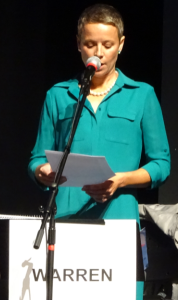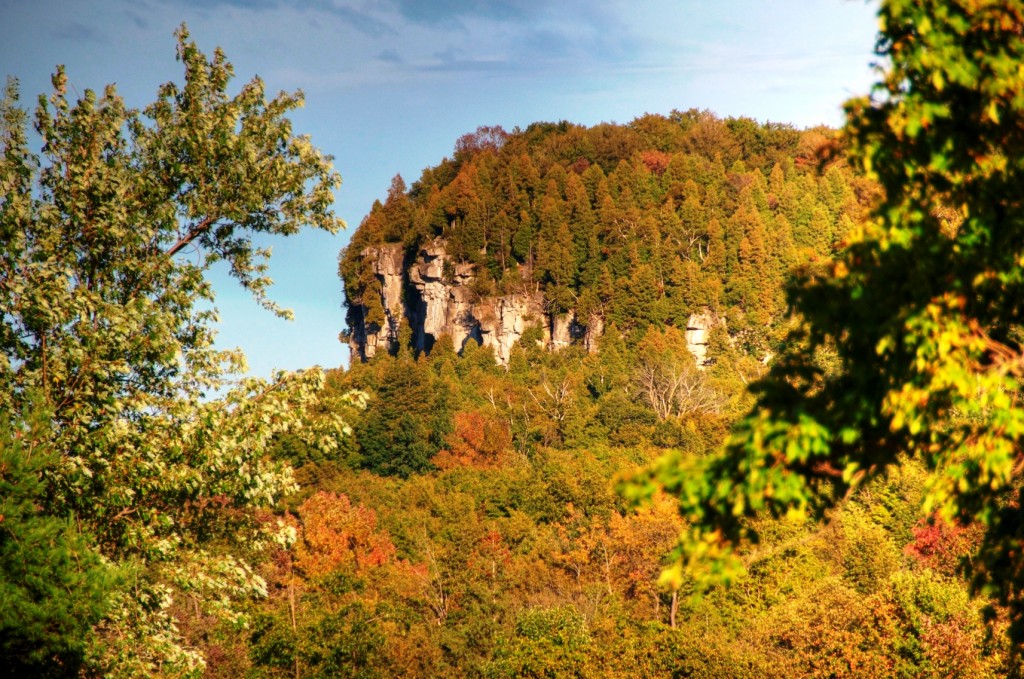 By Pepper Parr
By Pepper Parr
March 18, 2015
BURLINGTON, ON
Part 1 of a 2 part feature.
It was a gathering of the true believers – they met at McMaster University’s DeGroote campus in Burlington to listen to environmental advocate lawyer David Donnelly, Oakville Mayor Rob Burton, Suzuki guy and female planner who focused on what they see as a threat to Ontario’s Greenbelt.
It was defined as an occasion to celebrate and a time to hunker down and make sure that the gains made are not taken away as the Ministry of Municipal Affairs and Housing (MMAH) holds a series of Town Hall meetings across the province.
It is a delight to listen to Oakville Mayor Rob Burton talk about how that town managed to “green” its Council and to listen to David Donnelly proselytize about the environment.

Vanessa Warren, founder of the Rural Burlington Greenbelt Coalition, ran as a candidate in the last Burlington municipal election.
Vanessa Warren, founder of the Burlington based Rural Burlington Greenbelt Coalition (RBGC) bounced about the room introducing people and keeping things going.
Warren first crossed Burton’s path when she was delegating to Halton Regional Council on the Burlington Air Park problems. At that time Burton explained to Warren that she had more clout with the Air Park issue than Regional Council.
Several months later, Warren was sued for libelling the Air Park ownership and hired David Donnelly to defend her. Full disclosure: The Gazette is a party to the libel law suit – but we are not being defended by Donnelly. The evening was almost a family get together.
The purpose of the meeting was to get the community ready for the provincial Town Hall meetings that are looking at the way the province and its municipalities do land use planning.
The Smart Growth for Communities Act – Bill 73 is the focus point – does the bill give the environmentalists what they are looking for and can the developers live with it.
Rob Burton, in a style that is all his own explained how to make a city council green.

Oakville Mayor Rob Burton
“Back in 2006” said Burton, “we thought if we could elect one green councillor we were on our way to saving the planet. They elected Allan Elgar.
About 18 months into his term of office Allan said to his green cohorts – one man isn’t enough. Come the 2010 election they got three greens on the Oakville city council.
Eighteen months into that mandate the group came to the realization that three wouldn’t do it – so in the 2014 term they elected seven greens.
Rob Burton feels he is on his way and is ready to plunge into the MMAH Town Hall meetings.
Burton explained what Oakville and to some degree the Region has done to protect its environment. What he didn’t tell the audience was how Oakville pressured the provincial government to keep a gas plant out of the municipality – the fallout from the way that was done cost former Premier Dalton McGuinty the government he had then and continues to plague current Premier Kathleen Wynne.
Burton, talking to an attentive crowd – 125 people with more than half from outside the Region, said that while there is a provincial policy and a Regional policy” we in Oakville have carved out Natural Heritage sites (NHS) that fit in with and compliment the Regional and provincial policies.
Councillors Taylor and Meed Ward were on hand from Burlington.
Halton Region Natural Heritage System (NHS) covers 48,000 hectares in the greenbelt, farmlands and urban areas
The Halton NHS goes beyond provincial designations by adding new key features for permanent protection of significant woodlands; they have created buffers and linkage corridors to connect the key natural heritage features.

There are development corporations that would love to put residential housing on the Escarpment – not on say the environmentalists.
Burlington is currently working on a vision for Mt Nemo plateau and undertaking a Heritage Conservation District Study. Nemo 7G/PERL formed a seven-generation, (150 years) vision for the plateau. Mt. Nemo has been identified as one of the best examples of high diversity and functioning ecosystems in the GTA-Hamilton area.
From October 2013 to January 2014, the government undertook province-wide consultations on the land use planning and appeal system, and development charges system to ensure both systems are predictable, transparent, cost effective and responsive to the changing needs of our communities. The government is responding to comments received through the consultations and has announced proposed legislative amendments to the Development Charges Act, 1997 and the Planning Act.
If passed, Bill 73 – the proposed Smart Growth for Our Communities Act would give residents more say in how their communities grow, set out clearer rules for land use planning, give municipalities more independence to make local decisions and make it easier to resolve disputes.
For example, residents would be better involved at the beginning of the planning process and have a say in the future of their communities. Municipalities would need to set out in their official plans how and when the public would be consulted, and would also need to explain how public input affected their planning decisions.
The bill would also: give municipalities more opportunities to fund growth-related infrastructure, like transit; make the development charges, section 37 density bonusing and parkland dedication systems more predictable, transparent and accountable; and support higher density development to create jobs and grow the economy.
The province will be setting up working groups of stakeholders to review further more complex development charges issues, and to take a considered look at some land use planning elements, and propose solutions.
Both Burton and Donnelly point to significant successes and believe the tide is turning and the tipping point is at hand.

This little guy was a significant part of the end of quarrying in rural Burlington.
They point to the October 11, 2012: Joint Board decision that dismissed Nelson Aggregate Co.’s applications for a proposed 26 M tonne quarry on 82 ha site. That decision focused on impacts to Jefferson Salamander and its habitat in the context of the Niagara Escarpment Plan (NEP)
In September 17, 2014 the Niagara Escarpment Commission (“NEC”) voted in favour of an outright ban on new quarries in the NEP; that vote went 7 Commissioners in favour, 5 Commissioners against
The 2015 Greenbelt Plan Review is something environmentalists have been waiting for – the Town Hall meetings are just one part of the process. Many people take considerable comfort from the appointment of former Toronto Mayor David Crombie being appointed chair.
This process is something to be watched.


















